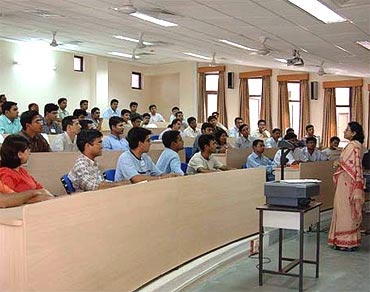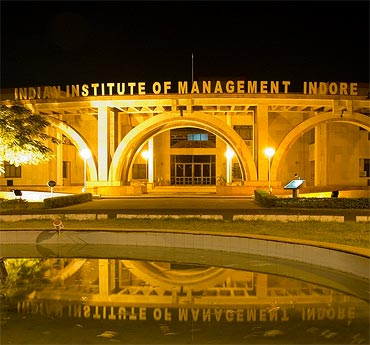Vasundhara Vyas
With 15 per cent lesser number of candidates taking the Common Admission Test (CAT) this year and the number of seats in all the Indian Institutes of Management (IIMs) put together increased, is there a better chance for a candidate to get in?
The IIMs have started talking about handling their biggest batch already, but with the expansion to accommodate the non-creamy layer amongst the other backward classes (NC-OBC) category students as per the directions of the Supreme Court finally in place, the intake capacity of the brand IIM has reached a total of about 2,600 seats.
This figure also includes the number of seats that all the new IIMs (Raipur, Ranchi, Rohtak and even Trichy) will be offering.
"PaGaLGuY.com is India's biggest and most trusted MBA preparatory resources website, using technology, community and high quality content to empower the MBA aspirant community."
IIMs to offer 1,200 more seats this year
Image: IIM-AhmedabadAll the government institutes were asked by the Supreme Court ruling that they would have to accommodate 27 per cent of NC-OBC candidates. Institutions, which included the IIMs and IITs, had agreed to accommodate the NC-OBC category, but only on the condition that they would not reduce the number of general and other category seats.
For this, the institutes (older six IIMs -- Ahmedabad, Calcutta, Bangalore, Indore, Kozhikode and Lucknow) brought about a 54 per cent hike in the total number of seats, offering 27 per cent of the seats to NC-OBC candidates with the number of seats for general category, SC, ST and differently-abled categories remaining the same.
These means that of the 2,600 seats offered by the 11 IIMs, there are about 1,235 seats that can accommodate candidates from the general category.
IIMs to offer 1,200 more seats this ye
Image: IIM BangaloreIn the academic year beginning 2007, the total number of seats offered by IIMs were about 1,400 of which the general category seats were almost 1,043. So, the effective increase in the number of seats for general category students is less than 200, inclusive of those offered by the five new IIMs.
If the candidate is from the NC-OBC category then, there is some good news. There are now almost 700 seats especially for this category of candidates.
Interestingly, the number of general category candidates taking CAT 2010 has dropped by one per cent to 81 per cent compared to that in CAT 2009.
The percentage of NC-OBC category candidates taking the test remains the same at 11 per cent.
The other thing that is becoming commonplace on the institute web sites but has been existing for a few years now is the institutes inviting overseas candidates.
IIMs to offer 1,200 more seats this year
Image: IIM IndoreEvery year, IIM-A alone admits overseas candidates who constitute 5-10 per cent of the batch.
"Though there is no separate category like the overseas category, the students with the overseas certificate who meet the eligibility criteria are considered like any other domestic students. These students have to submit their GMAT scores and if they get selected, they have to appear for the interviews with all the other candidates, selected through CAT scores," says professor Diptesh Ghosh, the Admissions chairperson for IIM-A.
So these overseas candidates, most of whom have been working abroad for a couple of years and want to pursue their higher education, compete with the domestic candidates. Even these candidates can apply for admission under a specific criteria: NC-OBC / SC / ST / DA so they would be considered under that particular category.
The fees for these candidates are more or less equal to the domestic students, but to be paid in US dollars.
The older IIMs have upgraded their facilities and developed their infrastructure like new hostel buildings and class rooms to accommodate the seat expansion.
IIMs to offer 1,200 more seats this year
Image: IIM RanchiThis could be one of the best times to join these institutes with the brand new hostel rooms and new academic blocks.
One thing that almost all the IIMs are lagging behind is on the student-teacher ratio front.
With the number of students increasing in the flagship post graduate programme in management (PGP), most of these institutes also offer the post graduate programme in Agri-Business Management (PGP-ABM), executive education programme (PGPX) and Management Development Programmes (MDP).
Each of these institutes, including the new ones need at least an appointment of 10 to 15 permanent faculty members to be in a comfortable situation and to reach a student teacher ratio of around 10:1.







Comment
article